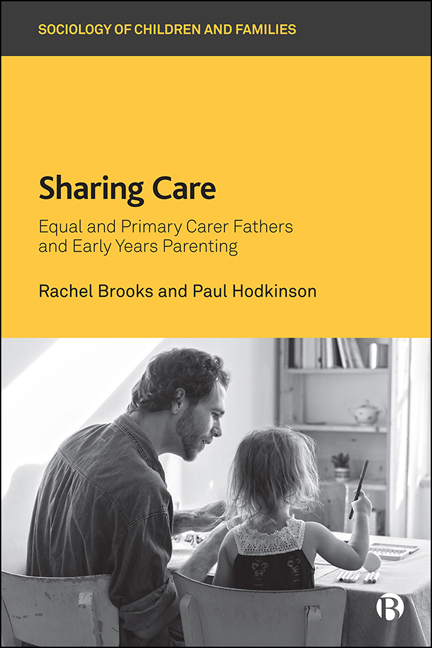Book contents
- Frontmatter
- Dedication
- Contents
- Acknowledgements
- 1 Sharing Care: An Introduction
- 2 Extended Fatherly Involvement: Development and Understandings
- 3 Developing Policy Support for Care-sharing: And its Limitations
- 4 Shifting Care Horizons: Care-sharing Arrangements, Motivations and Transitions
- 5 Developing Fatherly Roles and Identities: Towards Parental Equivalence?
- 6 Daytime Social Isolation from Other Parents
- 7 Care-sharing Futures
- Appendix: Table of Participants
- References
- Index
5 - Developing Fatherly Roles and Identities: Towards Parental Equivalence?
Published online by Cambridge University Press: 11 March 2021
- Frontmatter
- Dedication
- Contents
- Acknowledgements
- 1 Sharing Care: An Introduction
- 2 Extended Fatherly Involvement: Development and Understandings
- 3 Developing Policy Support for Care-sharing: And its Limitations
- 4 Shifting Care Horizons: Care-sharing Arrangements, Motivations and Transitions
- 5 Developing Fatherly Roles and Identities: Towards Parental Equivalence?
- 6 Daytime Social Isolation from Other Parents
- 7 Care-sharing Futures
- Appendix: Table of Participants
- References
- Index
Summary
Introduction
In this chapter we turn to the detail of how the sharing of care by fathers was working out in practice and the significance of this for their caregiving approaches, identities and horizons. In particular, we explore how roles and responsibilities were divided between the fathers and their partners, examine similarities and differences in their styles of parenting and outline how the fathers had come to view themselves and their roles. We already have established in Chapter 4 that, through taking on their unusually involved caregiving roles in the first place, the fathers had taken a substantial step outside of dominant understandings of early fatherhood and, often, one that also represented a turning point from their own early practices and expectations. In the coming pages, we ask what happened next, and how far the fathers’ challenge to dominant ways of ‘doing gender’ in early parenthood went. Against the context of somewhat contrasting arguments in existing literature, we ask how comprehensive their caregiving responsibilities had become and the extent to which their identities and practices demonstrated a movement towards gender-neutral approaches to parenting. We also identify some barriers that sometimes placed limits on the scope of the fathers’ caregiving roles and the transformations of their identities and horizons.
Fathers or gender-neutral parents?
As outlined in Chapter 2, indications from existing research on primary carer fathers are somewhat inconsistent when it comes to the extent to which their fatherly approaches and identities come to resemble those normally associated with mothers. For Andrea Doucet (2009), the ongoing significance of long-term gendered habitus prompts even those fathers who have taken on the most extensive practical caring responsibilities to reject the notion that their roles or identities resemble those of mothers (see also Doucet, 2006a). Doucet (2009) reports, for example, an overwhelming belief, even among full-time stay-at-home fathers, in a unique emotional and physical bond between mother and baby, something often connected with perceived differences between themselves and their partners in terms of approaches to care, comfort and nurturing.
- Type
- Chapter
- Information
- Sharing CareEqual and Primary Carer Fathers and Early Years Parenting, pp. 113 - 144Publisher: Bristol University PressPrint publication year: 2020



